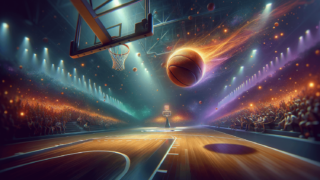
What’s a Triangle and Two Defense in Basketball?
Written by: Basketball Universe
Last updated:

When you dive into the fascinating world of basketball, it’s not long before you come across various defensive strategies with intriguing names that leave even the most seasoned fans scratching their heads. One such compelling defensive tactic is the ‘Triangle and Two Defense’. Are you eager to demystify the secrets behind this strategy and level up your basketball knowledge? Well, buckle up as we embark on an exciting journey to explore the ins and outs of this hybrid beast of a defense, leaving no stone unturned in our quest to transform you into a Triangle and Two Defense connoisseur!
What’s a Triangle and Two Defense in Basketball?
A Triangle and Two Defense is a hybrid defensive strategy in basketball that mixes elements of man-to-man and zone defenses. In this approach, three players form a triangle-shaped zone defense near the basket, while the remaining two defenders play man-to-man coverage on the opposing team’s top two offensive threats. This strategy is primarily used to disrupt the offensive flow and limit the effectiveness of the most dangerous scorers on the other team.
The Origins of the Triangle and Two Defense
While the exact origins of the Triangle and Two Defense remain a topic of debate among basketball aficionados, most agree that its emergence can be traced back to the creative minds of determined coaches seeking an edge against high-scoring opponents. Often seen as a rare and specialized tactic, the Triangle and Two Defense has showcased its effectiveness in both collegiate and professional basketball environments when executed correctly. So, let’s dive deeper into this defensive enigma, examine its inner workings, and unravel how it can turn the tide in a heated basketball game.
Understanding the Triangle Defense
Positioning of the Three Players
The term “triangle” in the Triangle and Two Defense refers to the three players who are responsible for forming a dynamic zone defense near the basket. These players typically consist of two forwards and a center, and their primary task is to defend against interior plays and secure rebounds. The key to an effective triangle formation is communication and awareness, as these players need to seamlessly move and rotate to fill gaps created by the opposing offense. By making rapid adjustments, they can ensure that the hoop remains off-limits to the rival team’s scorers.
The Triangle’s Defensive Responsibilities
While the primary job of the triangle-zone defenders is to protect the paint, they are no less vigilant against threats from the perimeter. Their responsibilities include:
- Denying easy inside passes and entry plays.
- Challenging shots near the basket and avoiding fouls.
- Securing defensive rebounds and initiating fast-break opportunities.
- Showing help and support to the two man-to-man defenders in case of screen plays or unfavorable mismatches.
- Reacting quickly to offensive adjustments, such as skip passes, and closing out on shooters.
Through synergy and adaptability, the triangle defenders create a formidable barrier that confounds and frustrates their basketball adversaries.
Focusing on the Two Man-to-Man Defenders
Selection of the Two Defenders
As the name suggests, the “two” in the Triangle and Two Defense refers to the pair of players assigned to play a more aggressive man-to-man defense, typically against the rival team’s primary offensive threats. These players, often guards or wing defenders, must possess quickness, agility, and the tenacity to keep their assigned targets in check throughout the game. A thorough understanding of their opponents’ offensive tendencies, strengths, and weaknesses can go a long way in shutting down the rival team’s best scorers.
The Man-to-Man Defensive Duties
These specially assigned defenders have some crucial tasks to accomplish for the Triangle and Two Defense to be successful:
- Staying glued to their assigned players and denying them open looks or easy scoring opportunities.
- Fighting through screens and maintaining constant pressure on their marks.
- Helping the triangle defenders by cutting off passing lanes and forcing turnovers.
- Contesting shots aggressively to decrease shooting percentages.
By focusing on these objectives, the two man-to-man defenders can significantly impact the offensive flow of the rival team, often resulting in a decline in scoring production and an increase in turnovers.
What Teams Can Benefit from the Triangle and Two Defense?
The Triangle and Two Defense is not for every basketball team, as it requires a unique combination of skills, mindset, and coaching prowess to execute effectively. So, which types of teams can flourish under these tactical conditions?
- Teams with versatile defenders: This defensive strategy necessitates versatile and adaptable defenders who can make swift rotations, switch effectively between zone and man-to-man defensive duties, and maintain constant communication with their teammates.
- Teams facing opponents with a strong one-two punch: When confronting a rival team boasting two dominant offensive forces, the Triangle and Two Defense can limit their scoring opportunities and force other players to step up.
- Teams looking to disrupt offensive flow: This unconventional strategy can catch unprepared opponents off guard and break their rhythm, leading to lower shooting percentages and increased turnovers.
Despite these advantages, the Triangle and Two Defense might not be ideal in situations where the opposition has a balanced scoring attack or the zone defenders lack the necessary mobility and communication skills.
Preparing and Implementing the Triangle and Two Defense
Practice Drills and Scenarios
To master the Triangle and Two Defense, teams should frequently practice it during their training sessions. They can focus on drills that improve communication, awareness, and defensive readiness. Practice scenarios should encompass various tactical adjustments that might occur in a real game, allowing players to grow accustomed to making effective defensive decisions under pressure.
Coaching and Player Input
Coaches must play an active role in helping their teams understand the nuances of the Triangle and Two Defense. By providing constructive feedback, coaches can help players refine their defensive technique and decision-making. It is also crucial for players to share their experiences and insights to improve team cohesion and adaptability.
Using the Triangle and Two Defense as a Change-up Strategy
When implementing the Triangle and Two Defense, it can be beneficial to use it as a strategic change-up to disrupt the opposing team’s offensive rhythm. By switching between conventional and unconventional defensive alignments, teams are better equipped to keep their opponents guessing and limit their scoring potential. This approach, combined with a disciplined execution of the Triangle and Two Defense, can elevate a team’s defensive prowess in the world of basketball.
Countering the Triangle and Two Defense
Though the Triangle and Two Defense can be challenging to contend with, it is not insurmountable. A combination of astute coaching and intelligent, adaptable players can exploit its defensive gaps and create open scoring opportunities. To effectively challenge this defensive strategy, let’s delve into some actionable tips and offensive maneuvers.
Moving the Ball and Finding the Open Player
Offensive teams confronted with the Triangle and Two Defense should focus on rapid ball movement and dribble penetration to disrupt and compromise the structure of the triangle. Overloading one side of the zone frequently causes mismatches and forces the triangle players to rotate, leaving advantageous situations for open teammates to capitalize on.
Screening the Man-to-Man Defenders
Implementing screens against the two man-to-man defenders can create open looks for the primary scorers, and potentially disrupt the defensive organization. For example, setting back screens, down screens, and ball screens are all techniques that can help shake loose the two scorers being guarded man-to-man, compelling the triangle defenders to react and leaving openings for scoring opportunities.
Utilizing Triangle-Split Actions
Having offensive players execute a split cut (a simultaneous action whereby one player screens for another) near the top of the triangle formation can help create some confusion in the defense. This well-timed action might cause defenders to switch, hesitate or lose track of their assignments, opening up easy scoring options for the offense.
Significance of Offensive Rebounds
When facing the Triangle and Two Defense, securing offensive rebounds can be a game-changer as it creates additional scoring chances while wearing down the defense. Encouraging players to crash the boards with determination and persistence can shift the momentum in favor of the offense.
Analyzing Notable Episodes of Triangle and Two Defense in Action
To appreciate the potential impact of the Triangle and Two Defense in basketball games, let’s examine some instances where this defensive strategy garnered significant attention:
2009 NCAA Tournament: Missouri vs. Memphis
In a scintillating matchup during the 2009 NCAA Tournament, the University of Missouri employed the Triangle and Two Defense to stymie the high-powered Memphis offense. The result: Missouri upset Memphis to advance to the Elite Eight. By effectively limiting the scoring opportunities of Memphis’ primary offensive weapons, Missouri’s Triangle and Two Defense played a pivotal role in the team’s success.
2019 NBA Finals: Toronto Raptors vs. Golden State Warriors
During Game 2 of the 2019 NBA Finals, the Toronto Raptors unleashed a Triangle and Two Defense in an attempt to contain the offensive juggernaut that was the Golden State Warriors. Although the Raptors ultimately came up short in that game, their unorthodox strategy drew widespread attention and demonstrated the disruptive potential of the Triangle and Two Defense at basketball’s highest level.
In both of these examples, the Triangle and Two Defense either drastically impacted the game or, at the very least, turned heads and generated conversation. As a result, it remains a topic of fascination and untapped potential within the strategic realm of basketball.
Frequently Asked Questions about Triangle and Two Defense
Still curious about the intricate details of the Triangle and Two Defense? Let’s tackle some frequently asked questions about this unique defensive strategy that continues to intrigue basketball enthusiasts at every level of the game.
1. Why is it called “Triangle and Two” Defense?
The name comes from the two main components of this defensive strategy: three players forming a triangle-shaped zone defense near the basket and the remaining two players playing man-to-man defense on the opposing team’s primary offensive threats.
2. What is the main purpose of the Triangle and Two Defense?
The primary objective is to disrupt the offensive flow of the opponent by limiting the effectiveness of their top two scorers, while keeping the other three players in a zone defense to protect the basket and grab rebounds.
3. How is the Triangle and Two Defense different from a traditional zone defense?
Unlike a traditional zone defense, where all five players are accountable for a specific area on the court, the Triangle and Two Defense involves three players in a triangular zone and two players assigned to man-to-man coverage on the opposing team’s most dangerous scorers.
4. When should a team consider using the Triangle and Two Defense?
It is most effective against teams with two primary scoring options, allowing the defense to focus on stopping those players while simultaneously providing cohesive coverage under the basket. It is also useful as an unexpected change-up to disrupt an opponent’s offensive rhythm.
5. How do teams typically attack the Triangle and Two Defense?
Some ways to counter the Triangle and Two Defense include rapid ball movement, dribble penetration, setting screens, and utilizing triangle-split actions. Teams can also focus on securing offensive rebounds to exploit the weaknesses of this defensive strategy.
6. Is the Triangle and Two Defense exclusively used in professional basketball?
No, the Triangle and Two Defense is not limited to professional basketball. It is often seen in collegiate and high school basketball environments, where coaches wisely employ this tactic to gain an edge against high-scoring opponents.
7. Can the Triangle and Two Defense work against an offense with multiple scoring threats?
Although the Triangle and Two Defense is primarily designed to limit the top two scorers, it can still provide some disruption against balanced offenses. However, its effectiveness may be diminished if the opponent possesses multiple players capable of creating and converting their shots.
8. How important is communication in the Triangle and Two Defense?
Communication is critical for successful implementation, as players must seamlessly move and rotate to fill gaps and provide help defense. Constant communication ensures that the defenders work in unison, making the defense more effective.
9. How can a team prepare for the Triangle and Two Defense?
Teams can engage in drills and simulations during training sessions to improve communication, defensive awareness, and adaptability. Working on specific tasks and responsibilities of each defender in the Triangle and Two Defense can also help teams become more comfortable and proficient with this strategy.
10. What are the weaknesses of the Triangle and Two Defense?
Some weaknesses include difficulty defending against well-balanced offenses or when players in the triangle formation lack communication and mobility. Another weakness arises when the two man-to-man defenders overcommit, leaving teammates exposed in the zone.
11. How can a team maintain consistency when using the Triangle and Two Defense?
Maintaining consistency involves frequent practice, in-game adjustments, and communication between players and coaching staff. Teams need to be familiar and comfortable with changing defensive looks and schemes to execute the Triangle and Two Defense effectively.
12. Can the Triangle and Two Defense be used as a full-time defensive strategy?
While it can be employed as a full-time strategy, the Triangle and Two Defense is often more effective when used as a change-up tactic to disrupt the opponent’s offensive flow. Regularly switching between different defensive alignments can keep the opposition guessing and make it harder for them to adjust.
13. How do offensive players increase their chances of success against the Triangle and Two Defense?
Offensive players can succeed by being highly aware of spacing, exploiting gaps in the zone, setting screens for their teammates, and staying active off the ball. Rapid ball movement and effective dribble penetration can also help combat the Triangle and Two Defense.
Featured Posts
- No pillar pages found.





